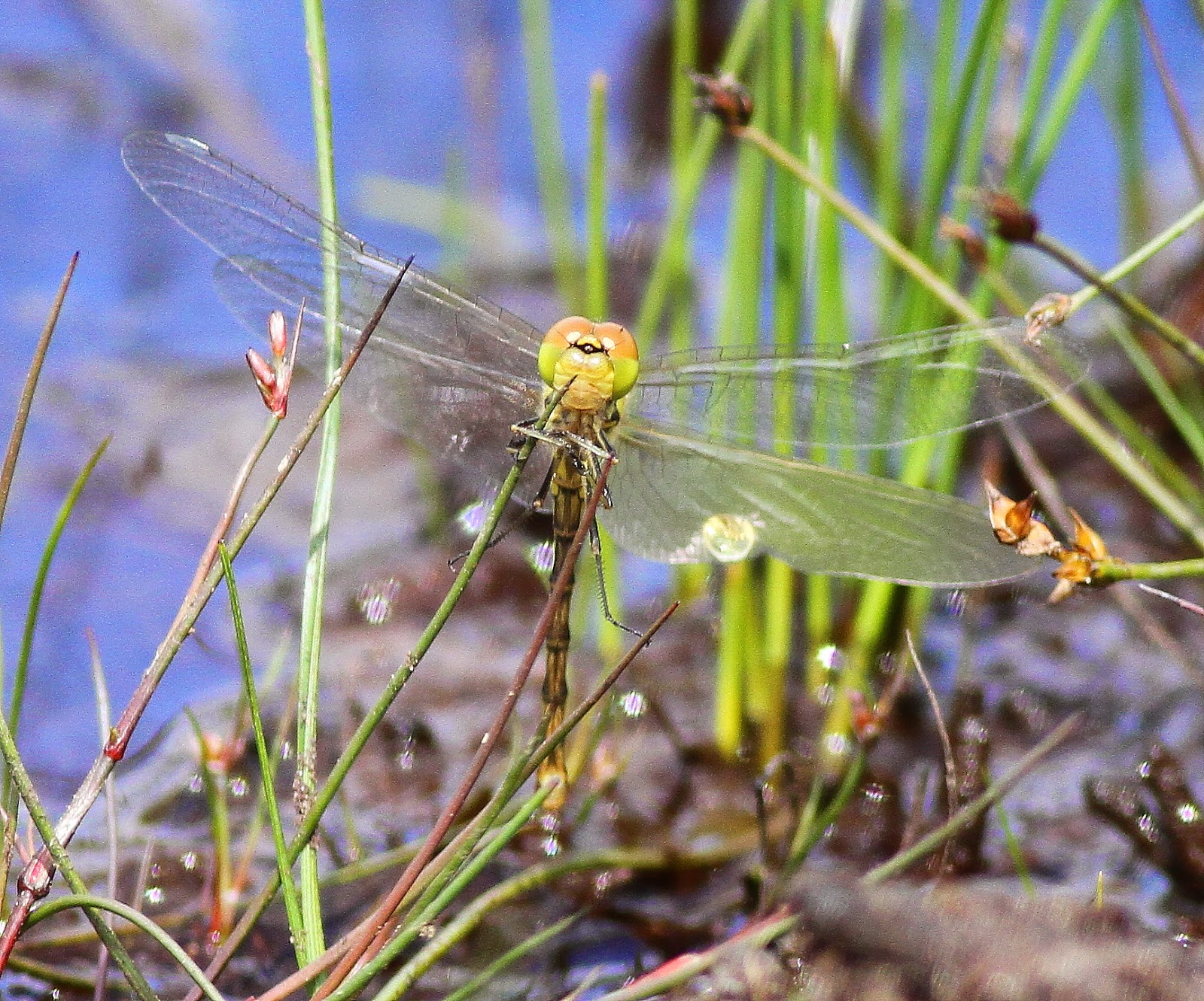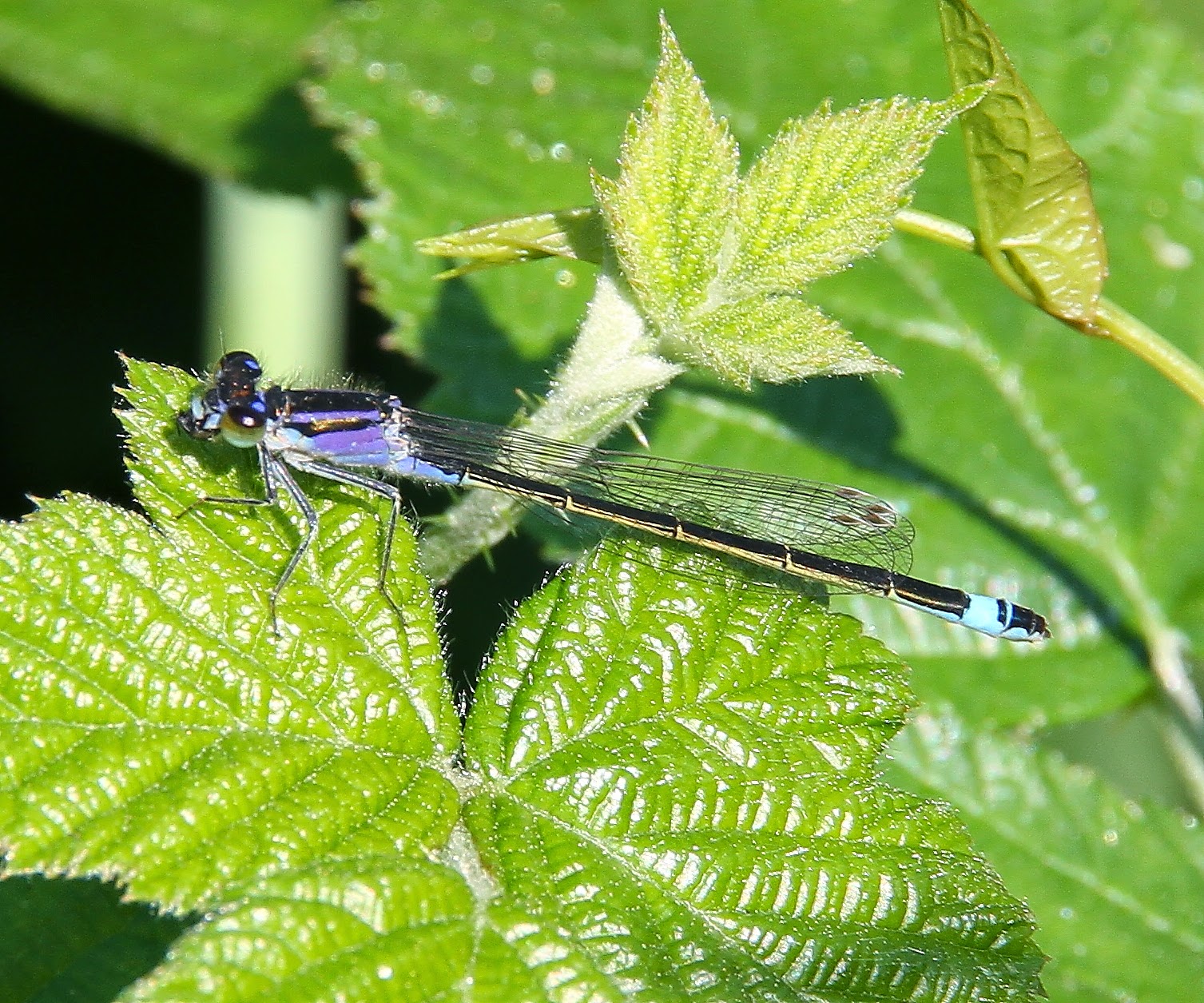One of the things I've been trying to do this Summer is see a few of the Dragonflies & Damselflies that I've not seen before. Also, I'm trying & get some decent photos of each of the UK species. There is only one Dorset species I've not seen before & that is Scarce Blue-tailed Damselfly. A good birding mate of mine, Kevin Lane, got in touch to say he had seen them over the weekend in the New Forest. So it seemed a good idea to take advantage of the ongoing decent weather & head over there. It would give me a better idea of the habitat, before trying to find this uncommon species in Dorset. There are a couple of historical sites around the Poole Harbour & Purbeck areas close to me, which I would like to check out in the coming weeks.
The New Forest is just over the border in Hampshire. It will be a well known area to UK residents, but for the overseas readers of this blog, I'll give you a quick overview. The name is very misleading as it is some of the oldest forested and unfenced lowland in the Southern England. It was created as a protected area for hunting of Deer in 1079 by King William 1, also known as William the Conqueror, soon after William's invasion of the UK. It covered over 200 square miles in the South West corner of Hampshire, to the West of Southampton. This constant protection has resulted in a rich tapestry of heathland, woodland & more open grassland. The protection has continued for the area to this day, albeit the Deer are no longer hunted by the Royal Family. One of the good things is development within the New Forest has been limited, so that there are still large areas of open countryside. The local inhabitants have Commoners rights to graze Horses, Ponies & Cows throughout the New Forest & this has also helped to maintain this important habitat. Most of the New Forest is owned by the nation & the area was designated as a National Park in April 2006. It is a major tourist area & getting out on a Monday to avoid the crowds was a good idea. Having said that, the area I was visiting is on the North Western boundary of the New Forest & is probably one of the quieter parts.
The New Forest is just over the border in Hampshire. It will be a well known area to UK residents, but for the overseas readers of this blog, I'll give you a quick overview. The name is very misleading as it is some of the oldest forested and unfenced lowland in the Southern England. It was created as a protected area for hunting of Deer in 1079 by King William 1, also known as William the Conqueror, soon after William's invasion of the UK. It covered over 200 square miles in the South West corner of Hampshire, to the West of Southampton. This constant protection has resulted in a rich tapestry of heathland, woodland & more open grassland. The protection has continued for the area to this day, albeit the Deer are no longer hunted by the Royal Family. One of the good things is development within the New Forest has been limited, so that there are still large areas of open countryside. The local inhabitants have Commoners rights to graze Horses, Ponies & Cows throughout the New Forest & this has also helped to maintain this important habitat. Most of the New Forest is owned by the nation & the area was designated as a National Park in April 2006. It is a major tourist area & getting out on a Monday to avoid the crowds was a good idea. Having said that, the area I was visiting is on the North Western boundary of the New Forest & is probably one of the quieter parts.
Latchmore Brook & New Forest Horses
A typical New Forest view: The gentle slopes, grassy areas, low areas of Heather & patches of forest are all very typical
The Dragonfly areas are along the Latchmore Brook. As I started to walk from the car park I quickly ran into a Green Woodpecker & a party of Long-tailed Tits. There were a pair of Stonechats on the heath along with a few Meadow Pipits. But generally the birdlife was pretty quiet.A typical New Forest view: The gentle slopes, grassy areas, low areas of Heather & patches of forest are all very typical
Green Woodpecker: The females have black moustachials whereas the males have obvious red moustachials
Long-tailed Tit: Juvenile
The first Dragonflies seen were these Beautiful Demoiselles. They were along the length of the small river. The males were fairly approachable, but the females provided to be too skittish in the sunshine.
Beautiful Demoiselle: Male have a completely dark metallic blue underwing, whereas the similar Banded Demoiselles have a distinct band with a clear base & tip to the wing
Beautiful Demoiselle: Male. I couldn't resist another photo
Keeled Skimmer: Male. Also note the lack of dark markings at the base of the wing, which indicates this is a Skimmer & not one of the Chasers. The oblong marking (pterostigma) at end wing is yellow-brown in Keeled Skimmers, compared to dark brown or black in Black-tailed Skimmers
Common Darter: Immature Female. Note, the black legs with a yellow line down the outer edge (Ruddy Darters would have all black legs)
Common Darter: Immature female
Common Darter: Immature female Common Darters have a yellow thorax (while a female Ruddy Darter has a black T on the top of the yellow thorax)
Common Darter: Immature Female. Note, the black marking in the face is a line which does not continue down the sides of the eye (which it does in the other Darter species)
Large Red Damselfly: Female. The black bands extending up the abdomen indicates this is a female, males have more red in the abdomen with the black limited to the segments closest to the end of the abdomen
Having walked up & mainly down, I sat down by the end of the stream. Immediately, I did I saw a Damselfly fly a short distance & settle back down again. I could see it was a Blue-tailed Damselfly type & a quick check with the bins confirmed it was a Scarce Blue-tailed Damselfly. Care is needed to check the Damselflies as Kevin saw both species in this area.
After about half a mile of walking, but a lot of looking, I reached Kevin's site where he had seen the Scarce Blue-tailed Damselflies. I walked around the area, but there was no obvious sign of any Scarce Blue-tailed Damselflies, amongst the other more obvious species: Golden-ringed Dragonfly, many Keeled Skimmers, my first Common Darter of the year, Large Red & Azure Damselflies.
Keeled Skimmer: Male. Note, the wings face forward, the thin blue abdomen with no yellow edges and the black restricted to the extreme end of the abdomen Keeled Skimmer: Male. Also note the lack of dark markings at the base of the wing, which indicates this is a Skimmer & not one of the Chasers. The oblong marking (pterostigma) at end wing is yellow-brown in Keeled Skimmers, compared to dark brown or black in Black-tailed Skimmers
Common Darter: Immature Female. Note, the black legs with a yellow line down the outer edge (Ruddy Darters would have all black legs)
Common Darter: Immature female
Common Darter: Immature Female. Note, the black marking in the face is a line which does not continue down the sides of the eye (which it does in the other Darter species)
Large Red Damselfly: Female. The black bands extending up the abdomen indicates this is a female, males have more red in the abdomen with the black limited to the segments closest to the end of the abdomen
Scarce Blue-tailed Damselfly: Male. The blue is on segment 9 and the end of segment 8 (whereas it's on Segment 8 on Blue-tailed Damselfly)
Scarce Blue-tailed Damselfly: Male. Overall they are thinner & weaker bodied than Blue-tailed Damselfly
Blue-tailed Damselfly: For comparison, here is a Blue-tailed Damselfly with the blue on segment 8 and segments 9 & 10 being black (Swineham, 19 June 14)
The Scarce Blue-tailed Damselfly habitat: They were perching on the short stalks near to the stream
There were good numbers of Silver-studded Blues on the heath, as well as, the Large Skippers & Small Skippers: all the first I've seen this year.The Scarce Blue-tailed Damselfly habitat: They were perching on the short stalks near to the stream
Silver-studded Blue: Females are brown on the upperside. The superficially resemble the Brown Argus but only have orange spots on the hind wing (Brown Argus have obvious spots on all wings)
Silver-studded Blue
I don't really know much about plants, apart from Orchids, but there were a couple of interesting ones seen today.Silver-studded Blue
Round-leaved Sundew: One of my favourite plants, being one of the few carnivorous plants in the UK
Round-leaved Sundew: They are very common in the boggy parts of the New Forest
Bog Asphodel: Again a common bog species
Bog Asphodel: A larger clump
























